Mobile Core i7 920XM, Clarksfield: Nehalem on-the-go
by Jarred Walton on September 23, 2009 10:00 AM EST- Posted in
- Laptops
System Performance
We'll begin with a look at general system performance using applications that can take advantage of the multi-core processors.
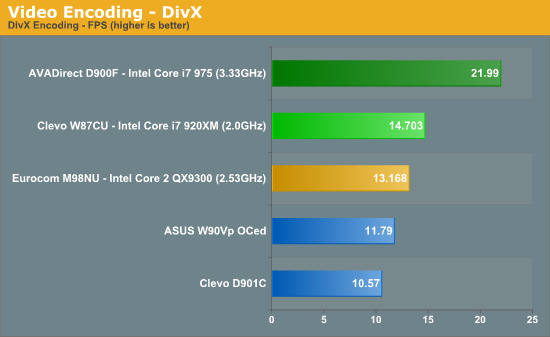
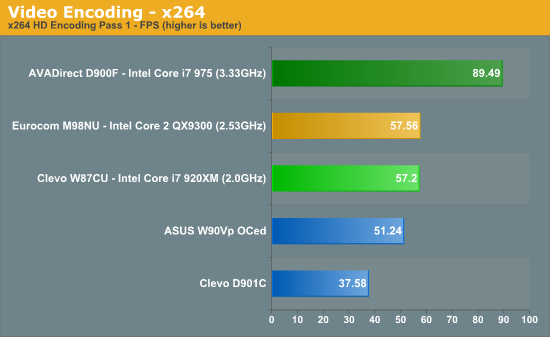
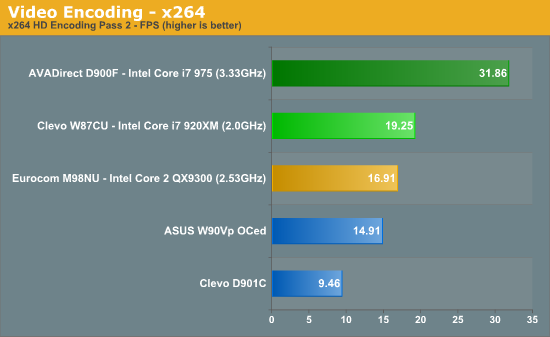
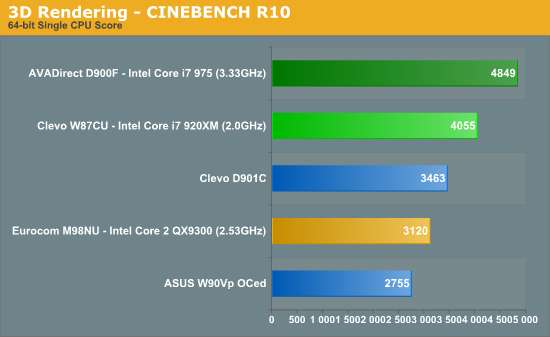
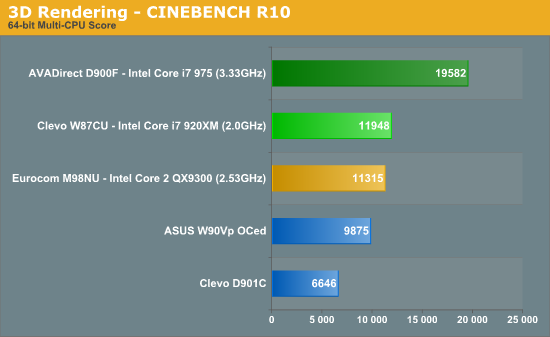
Application performance is about what you would expect given the CPU specifications. The new Clarksfield i7-920XM isn't substantially faster than the old Core 2 QX9300 when it comes to running highly threaded code. The problem is that when running highly threaded code, Clarksfield's Turbo modes aren't able to fully activate. We end up with a Core i7 running at 2.26 GHz compared to a Core 2 running at 2.53 GHz, and overall performance is relatively close. Clarksfield is 6% faster in SMP CINEBENCH, 14% faster in the second x264 pass, and 12% faster at DivX encoding. The first x264 pass is basically a tie. Move to single threaded performance and the Clarksfield Turbo modes are much more helpful, outperforming the QX9300 in single threaded CINEBENCH by 30%.
The QX9300 ends up being 12 to 15% faster than the overclocked Q9000 in the ASUS W90Vp - right in line with the difference in clock speed. Meanwhile the i7-920XM delivers a beating to the old Core 2 Duo E6850 (Clevo D901C) system. It's 17% faster in single threaded performance, but over twice as fast in the x264 second pass.
Naturally, the desktop i7-975 is substantially faster. It's only 20% faster in the single threaded CINEBENCH score, but it's 50 to 65% faster elsewhere. We should also mention that just because the rated clock speed of the i7-975 is 3.3 GHz doesn't mean the system always runs at that speed. The x264 encoding test runs each section four times, and normally all our results are very close. It appears that the i7-975 is throttling at times, as we noticed fluctuations in our x264 results. You'll want a nicely ventilated area if you want to get the advertised 3.33GHz, as otherwise it looks like the CPU may throttle down by as much as 30%.










63 Comments
View All Comments
Inkie - Thursday, September 24, 2009 - link
"They didn't prove anything, at all. You're just too stupid to see through the weird benchmarking. Maybe I stopped reading before they posted their 'proof'. But, really, Anand's apple to apple benches proved my point. In their first article, they were saying they were the same or better. Then, all of the sudden, the Bloomfield is 3.5% faster, normalized! Sometimes almost 10%, on real world benchmarks. Fancy that! Although, this time they screwed up by making the Bloomfield uncore faster, so it's not 100% accurate."That's nice, but the processors as they ship are not 'clock normalised'. As foretold, the benefit of extra clockspeed usually outweighs the benefit of playing with the memory subsystem. We all knew this and benchmarks confirm it, yet again. Many people don't give a shit about overclocking, you know, even if their major-OEM BIOS would allow them to do it. If I didn't need ECC, which causes me to buy Xeons, I'd definately choose Lynnfield on P55 over Bloomfield on X58, for any kind of comparable price. Not only is performance better, but power consumption is also better. Now, if you don't think that websites should benchmark at stock speeds, then maybe you should just move your ass to a specialist overclocking forum?
goinginstyle - Thursday, September 24, 2009 - link
TA152H,You stated - "Tom's also showed a lot of advantages of the Bloomfield. This site just rubbed me the wrong way because they were doing whatever they could to make the Lynnfield look better than it really is."
Fact -
1. AT's numbers are in alignment with everyone else on the web, including Toms. They are not trying to make Lynnfield look better than it is, it is just better in most cases than Bloomfield, so get over it.
You have harped on and on about clock for clock numbers, overclocked results, and all sorts of stuff that the people here at AT have provided. Even after providing proof, you still launch personal attacks at the editors and other readers because the numbers do not agree with your warped view of the world.
Fact -
1. Toms has not provided clock for clock comparisons, overclocked comparisons, or i7/860 comparisons. Neither have they equalized memory settings or shown results in several applications that AT added after the first review to give an additional look at each of the processors.
2. You did not comment at Toms (where you freelance apparently) about any of these items that you complained about at AT. Why is that?
You mentioned that Toms showed a lot of advantages for Bloomfield. Actually reading the review it was very few and far between, just like at most sites.
Fact -
1. Straight Quote from the summary at Toms and I do not see where they are crazy about Bloomfield except for the workstation crowd or those that have to have six cores on the desktop -
"...Now that we’ve had a couple of weeks with final hardware the Core i5 and Core i7 processor families are even more fascinating.
To begin, they make it much harder to recommend LGA 1366-based Core i7s. We know the i7-900-series is supposed to be higher-end, and it’s hard to ignore the fact that next year we’ll see hexa-core Gulftowns that drop right into our X58 motherboards. But seriously...
Alright, so the Core i5-750, specifically, is priced well. What is there to like about it? Reasonable power consumption, a base clock rate comparable to Intel’s Core i7-920, a more-aggressive Turbo Boost able to take the chip to 3.2 GHz in single-threaded workloads, CrossFire and SLI compatibility—it’s a pretty compelling list, actually.
...More attractive for the folks who stand to benefit from Hyper-Threading is Core i7-860. Its price tag puts it in the realm of Core i7-920, its Turbo Boost helps make it faster, and a complementary motherboard is going to cost you between $75 and $50 less."
Explain to us why those comments did not warrant a response from you at Toms in the same manner that you have posted here. They provided the same type of conclusion, only half the benchmarks and none of the followup by the guys here at AT.
Yet, you never once complained at your site about what you thought was a serious enough problem to call the editors here idiots and to make other personal attacks on their work. Why they have not banned you by this point is beyond me.
I did send an email to Chris Angelini tonight requesting him to read your posts here at AT and asking him if this is the type of employee Toms is proud to have on their staff. You have gone way beyond the norm in your continued attacks on this site and hopefully Chris will be a stand up guy and address this issue with you immediately.
Gary Key - Thursday, September 24, 2009 - link
"Also, you probably didn't notice, because Gary hid it, that the voltage needed to overclock the Lynnfield was considerably higher than the Bloomfield. "The voltages were never hidden, they were right there in the gallery along with the Uncore and memory subtimings as stated in the text. Regarding the uncore rates, they make very little difference, if any, except in the prized SuperPi benches.
Even though Lynnfield needed additional voltages to overclock, the total power consumption and thermals were still lower than Bloomfield. Say what you want, but Bloomfield is not significantly better in any regard for desktop users than Lynnfield. In fact, for most, the opposite is true.
JarredWalton - Wednesday, September 23, 2009 - link
uATX is smaller, and the cases are smaller, and so more heat is definitely a concern. You also are placing way more stock on places where Bloomfield wins and pooh-poohing any areas where Lynnfield wins or ties. There's no benchmarking silliness going on, except in your expectations.Places where Bloomfield clearly wins: WinRAR (super memory intensive, since it has to search for matching patterns when compressing). WME... does anyone really care about WME when we have x264 being clearly superior? And that's it. Everything else is within 5%, which is one speed bin.
To say that we tried to hide the additional voltage required for overclocking Lynnfield is another fabrication. There's a http://www.anandtech.com/cpuchipsets/showdoc.aspx?...">whole section where that is specifically addressed, as well as being mentioned in the conclusion about the "stock voltage overclocking". If you overclock, I hardly think voltages and power are your primary concern. You want to stay stable, and people have been boosting Intel CPU voltages far more than what we've done on Lynnfield.
Personally, Lynnfield makes more sense, simply from the financial aspect. If you want top performance, go for Bloomfield. If you want better performance without dropping a load, Lynnfield wins, even when you factor in overclocking. Only the extreme fringe is really concerned with more than Lynnfield offers. You're having fits over differences of 5% or less in most cases (DDR3-1066 vs. DDR3-1333, non-Turbo overclocked performance, etc.)
The only truly bad thing about the Lynnfield platform right now is that we're missing a decent IGP solution, and Intel is going to be the sole chipset provider for a good long time. Those are problems with Bloomfield as well, and they're not even serious concerns since you can easily add an inexpensive GPU.
That's my take anyway, but then I'm still perfectly happy with my desktop (overclocked) QX6700/Q6600 systems that I use for work and gaming. The headaches of trying to get everything transferred to a new system aren't worth the minor performance increases I'd see. Most of the time, my PC is waiting for me to finish typing/dictating/mousing.
strikeback03 - Thursday, September 24, 2009 - link
One other possible reason for X58 is extra PCI-E lanes could be used for USB3 or SATA3 controllers. If you are only using a single graphics card you still have another x16 for a controller, while with P55 its x8 and also drops the graphics card to x8.Cat - Wednesday, September 23, 2009 - link
I'd like to know how multithreaded apps perform (4-8 threads,) given that the CPU will definitely clock down under this kind of load. How does the mobile i7 perform compared to the mobile C2Q in this situation?Can you run Valve's particle or map compilation benchmarks?
Cat - Wednesday, September 23, 2009 - link
I know the CINEBENCH scores do provide some insight, but it's not representative the of workload I'll be using.JarredWalton - Thursday, September 24, 2009 - link
I'll see if I can dig out the old Valve SMP tests... or are there newer versions? The files I have seem rather old and outdated (pre-EP2) so I'd prefer a test that's current if you have anything.Anonymous Freak - Wednesday, September 23, 2009 - link
I'd be perfectly happy with the 820QM along with lower-end graphics. Maybe a nice 4830 or GeForce 9800? Something lower-power-using, but still adequate for most non-ultra-high-end games.My problem is that I like to have only a laptop as my primary computer; and I do things like edit HD video, so four cores are what I want; yet I want it to be portable and have decent battery life, too. (Yup, I have a MacBook Pro.) So the idea of the quad-core Clarksfield is perfect. It's a low-power-draw chip when not in full load, yet can ramp up very well for high-load situations; both low-threaded and multi-threaded. Now I want a GPU that is similarly dual-natured. Something with very low idle power, but which can ramp up to high-power when needed.
(I only do my serious high-load work when plugged in, so power draw at load doesn't matter so much, it's power draw at idle and low-load that matters to me.)
james jwb - Wednesday, September 23, 2009 - link
Power draw is too high for my liking, i was expecting better than this. More interested in Arrandale due to the above - quad-core is overkill for most on a laptop anyway.And someone bring an S-IPS panel to a laptop already!